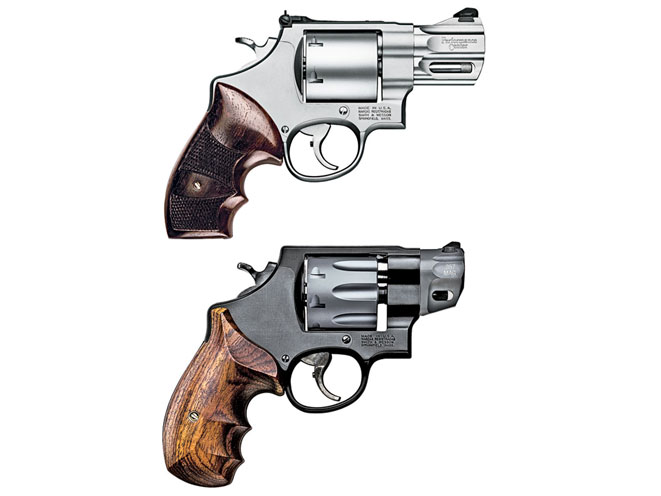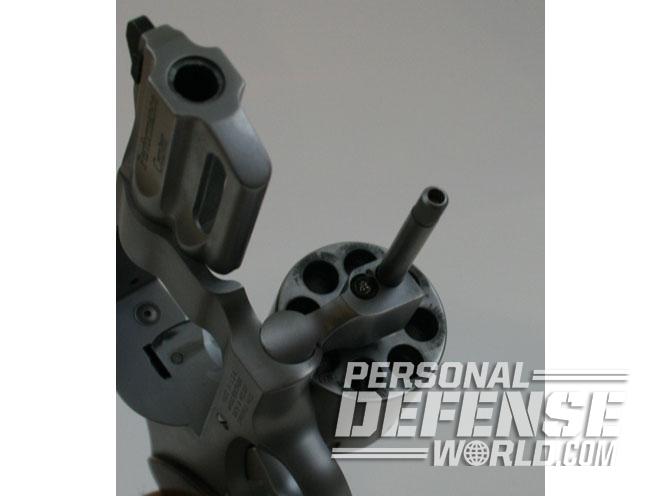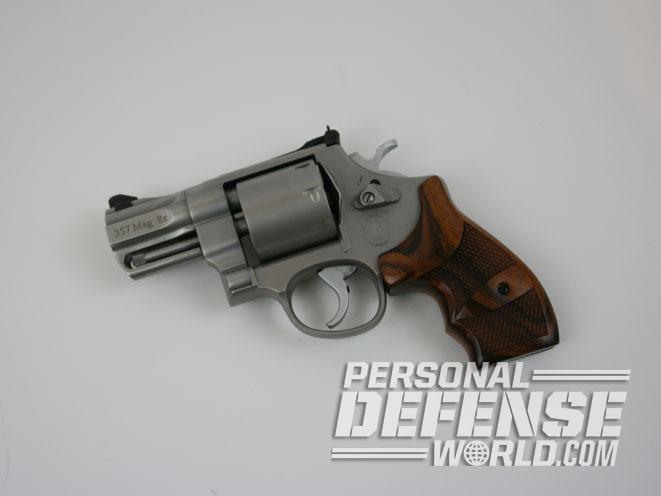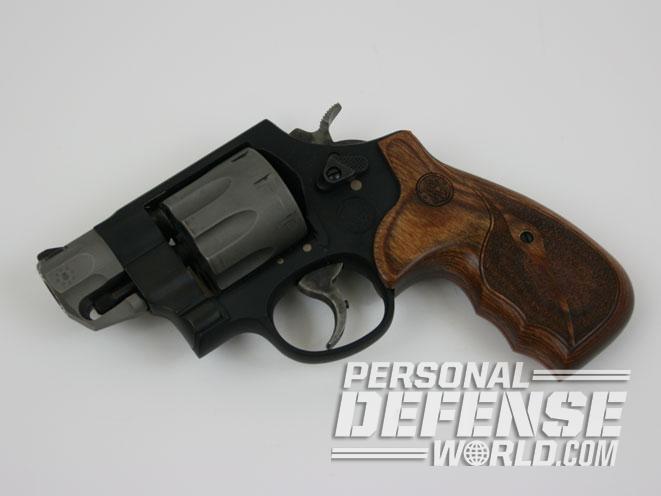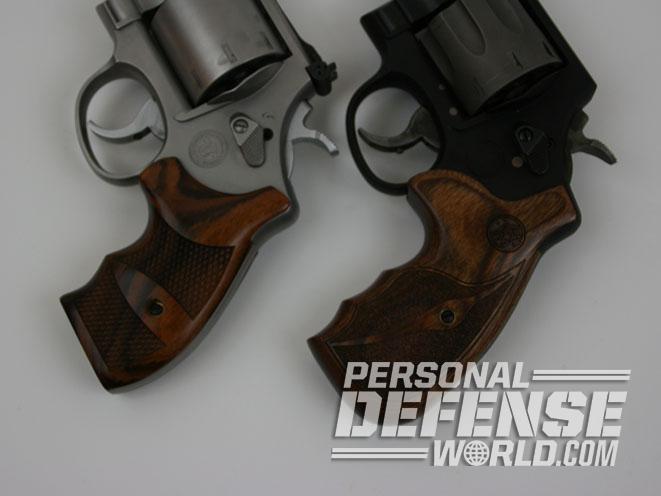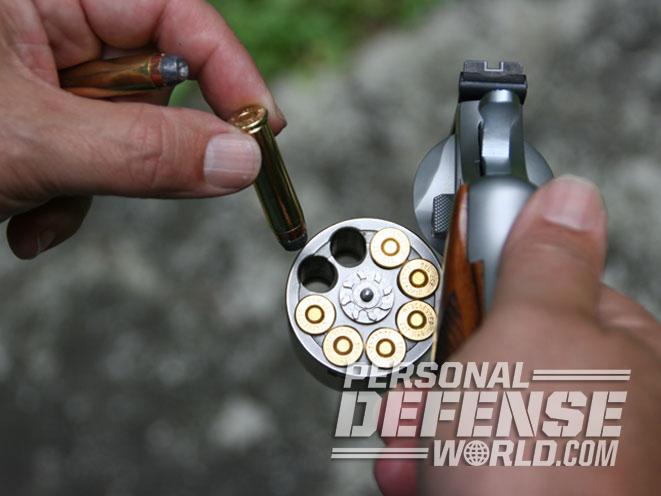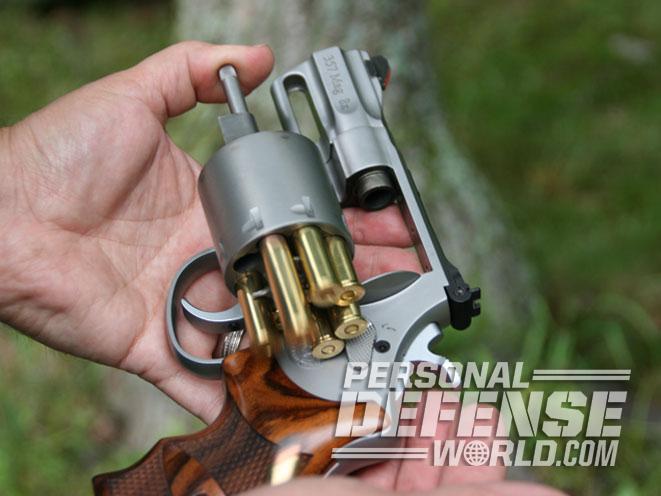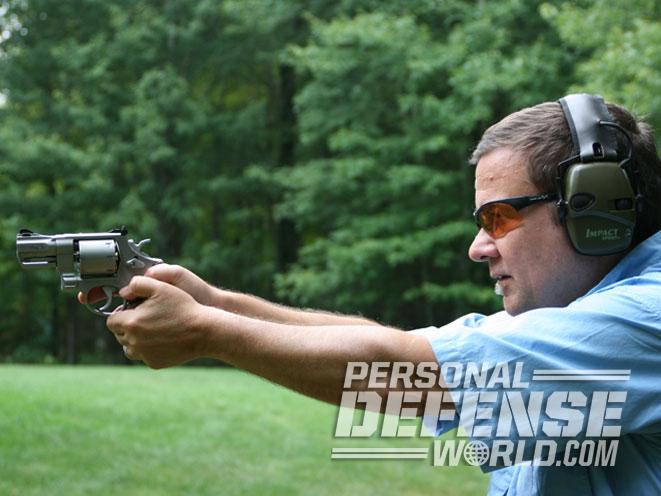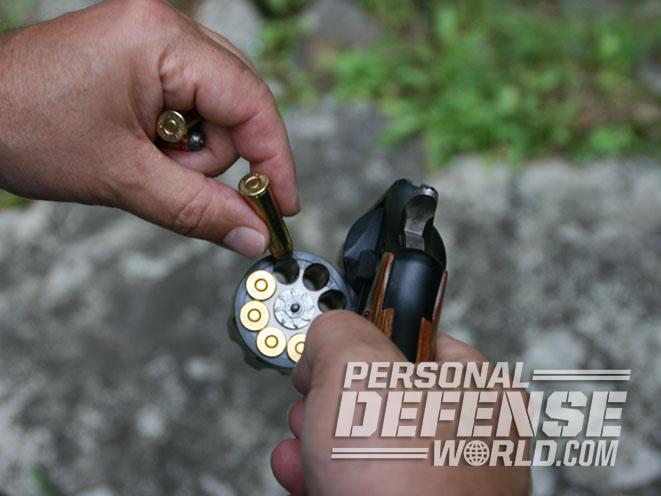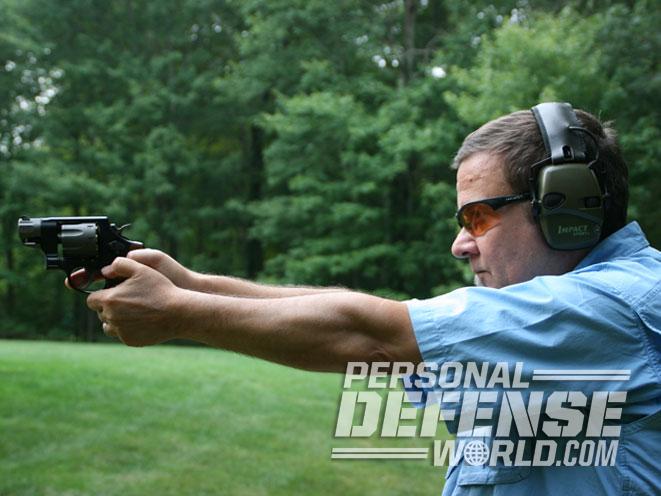With big-bore performance, size does matter. Smith & Wesson’s Performance Center takes one of the company’s largest revolver frames, the N-Frame, and packs eight rounds of .357 Mag firepower into its Model 627 and Model 327 designs. When you’re talking about snub-nose revolvers for concealed carry, however, N-Frames and eight-round capacities are hardly the norm.
The N-Frame is large. In the old days, making an N-Frame revolver into a concealed-carry weapon meant lobbing off some barrel length. The old steel, square-butt grip frames still wore full-sized grips, and it was still only a six-shooter. Always innovative even with the century-old N-Frame revolver design, alchemists in the Performance Center have created two eight-shooters that are 21st century revolvers made for concealed carry and offer plenty of punch.
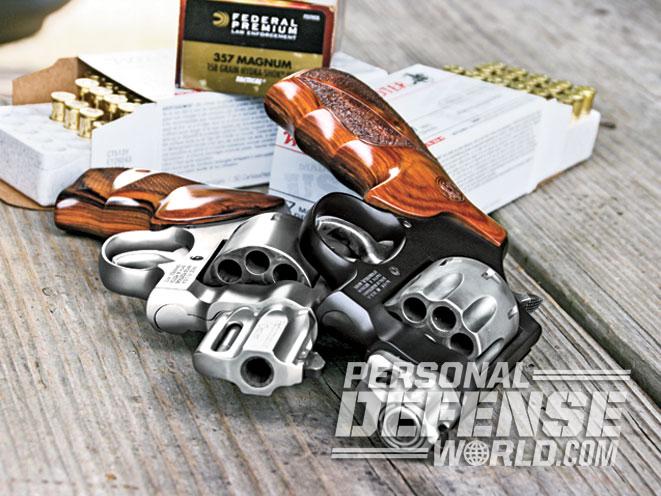
When the .357 Mag cartridge debuted it was nothing less than awe inspiring. In 1935 S&W introduced the first .357 Mag six-shot revolver, calling it the Registered Magnum. S&W chose to chamber the powerful cartridge in its large, heavy-duty, carbon steel N-Frame, the same frame that Smith & Wesson used for its .44 Hand Ejector chambered in .44 Special and the Model 1917 chambered in .45 ACP.
Advertisement — Continue Reading Below
RELATED STORY: A Brief History of the Smith & Wesson .357 Magnum Revolver
The combination of the new cartridge and the heavy-frame revolver was popular with law enforcement and with shooters, both of which couldn’t buy them fast enough, even in the midst of the Great Depression. Eventually, by the 1950s, the revolver was renamed the Model 27. The Model 627 and Model 327 have some the Model 27 DNA in them but they come out of the Performance Center with two different approaches to concealed-carry, high-capacity revolvers.
Next-Gen Wheelgun
Advertisement — Continue Reading Below
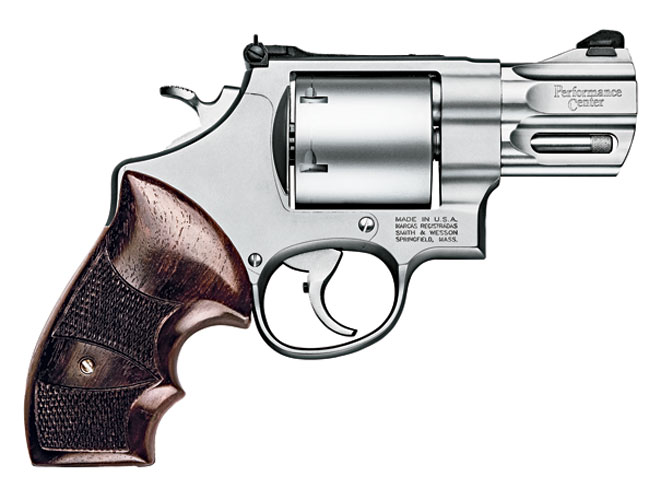
The Smith & Wesson Model 627 is constructed of stainless steel in a matte finish. The 2.6-inch-long barrel is slab sided and the muzzle crowned. The top of the barrel is serrated. The full-length ejector shroud is cut out to relieve some weight and to likely allow debris such as mud or snow to be easily removed if the revolver is dropped. The distinct, unfluted cylinder gives the Model 627 a no-nonsense and solid look. This is a heavy revolver—37.6 ounces unloaded—and is comparable in weight to a full-sized, steel-framed 1911. The Model 627 and the Model 327 are 1.7 inches thick compared to 1.3 inches of a typical 1911. That extra girth is barely noticeable when carrying either of these snub-nose revolvers in an outside-the-waistband (OWB) holster.
The Model 627’s sight setup features a ramp front sight with a red insert that is dovetailed into the barrel. It can be easily swapped out for something else if an operator so desires. The rear sight is fully adjustable and matte black with a white outlined notch. The sight picture is big, bold and to acquire.
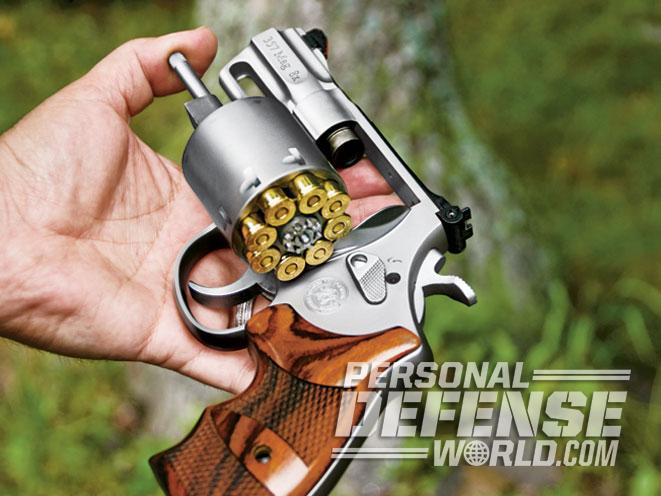
Advertisement — Continue Reading Below
The Model 627 has some heft to it, and in hand the small, finger-grooved boot grip is slim and fit nicely into my average-sized hand. The wood grip ends at the end of the Model 627’s frame and the frame’s backstrap was exposed. The checkered sections of the wood gave ample traction to grip the revolver even with hot loads. The Model 627’s trigger had an 11-pound pull but actually felt much lighter. A trigger stop was built in. The teardrop-shaped hammer offered excellent aggressive traction to thumb back and fire the Model 627 in single-action (SA) mode.
RELATED STORY: Gun Review – Smith & Wesson’s M&P40 Performance Center Ported
The cylinder latch on both the Model 327 and Model 627 made it easy to use speed loaders. Additionally, the left grip panel of each is scooped out for ease of use with a speedloader. The chambers are chamfered to also speed up reloading, plus the cylinders of both revolvers allow the use of moon clips. A ball detent is incorporated into the front of the crane on both of these Performance Center revolvers. This is an accuracy enhancement used by revolver competition shooters. The ball bearing locks into a V-shaped groove in the frame, and as promised the Model 627 and Model 327 locked up tight.
Advertisement — Continue Reading Below
High-Power Compact
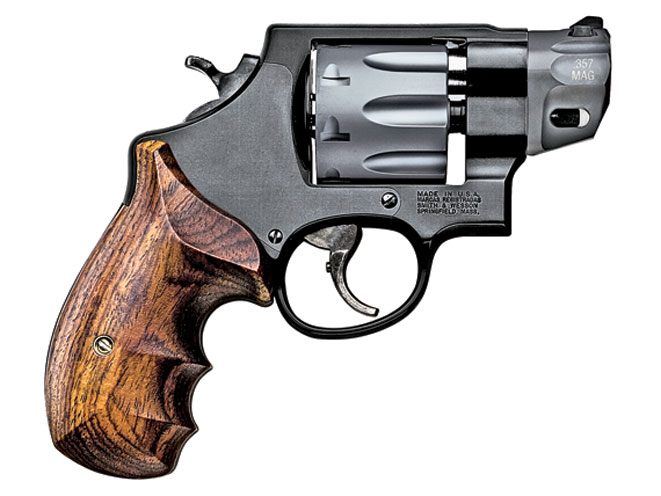
While the Model 627 uses more traditional material in its construction, the Model 327 is made with a scandium alloy frame, a steel barrel sleeve and a titanium cylinder and barrel shroud. The cylinder and barrel shroud have a light gray finish and the frame contrasts in matte black. This is a very lightweight revolver at only 24.7 ounces loaded.
RELATED STORY: Build Your Skill While Having Fun With The S&W M&P22 Compact
Advertisement — Continue Reading Below
The barrel on the Model 327 actually looks shorter than it is due to the shorter .357 Mag cylinder. There is a gap between the front of the cylinder and the frame. Since N-Frames were originally made for longer-rimmed cartridges like the .44 Special, the barrel is set back into the frame to meet the shorter cylinder, creating the illusion of a very short barrel. The Model 327’s sights consist of a dovetailed front ramp and a rear groove along the top of the frame. This setup proved fast on target and was made for close-quarters work.
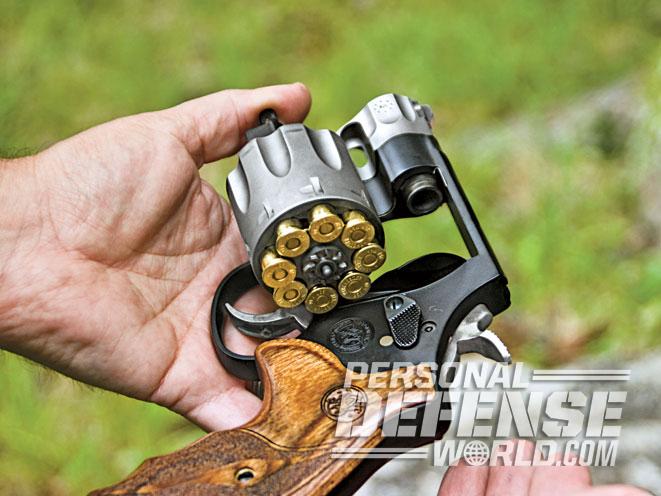
The Model 327’s barrel shroud was flat and chamfered, and the ejector rod shroud featured a cutout. The entire outer surface was dehorned so there was little threat of the revolver snagging when drawn from concealment. The smooth-faced trigger had a built-in trigger stop and was exceptionally smooth. During operation, it didn’t feel like it took 12 pounds of pull in double action (DA). The hammer was teardrop shaped and plenty toothy for cocking. The snub-nose has a full-sized grip so it fills your hand, and the sides were stippled for a sure grip. The backstrap was left exposed.
Advertisement — Continue Reading Below
Range Report
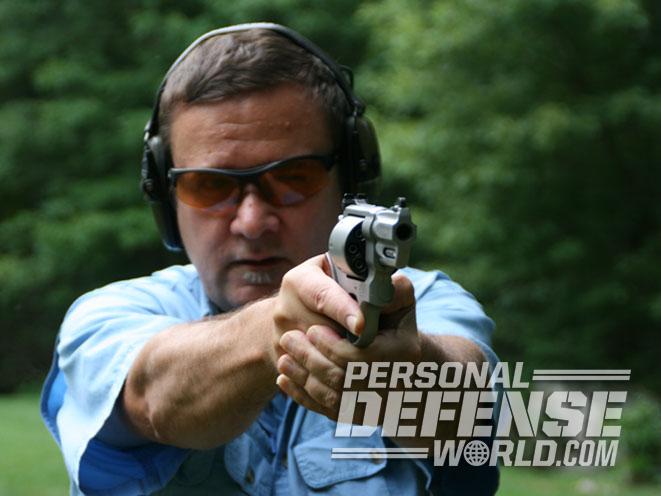
The weight of the Model 627 had a lot to due with its reduced felt recoil, even with its small boot-style grip, which required me to tuck my small finger under the grip’s butt. At 15 yards, both of these revolvers consistently produced five-shot group that averaged 1.5 inches. I ran a combination .38 Special +P and .357 Mag rounds through them.
Advertisement — Continue Reading Below
Firing for speed in DA, the Model 627 and Model 327 were easy to keep on target. There was a sense of “what’s the matter with this picture?” in pulling the trigger eight times instead of six, however. Reload time was significantly decreased through the use of moon clips, but the eight cartridges did take slightly more time to reload at times since there were eight rounds to align in eight separate chambers.
RELATED STORY: Next-Gen .357 Mag – The Smith & Wesson Performance Center M&P R8
The length of the ejector rod on the Model 627 allowed me to really shuck the eight empties. The ejector rod on the Model 327, meanwhile, was short due to the stubby barrel but it was enough to get the empty brass started and allow gravity to do the rest. The Model 327 had more felt recoil with the hot .357 Mag loads since the revolver was so light.
Advertisement — Continue Reading Below
With the correct holster and belt, these snub-nose revolvers are easy on the hip. For testing I used a Galco Combat Master belt holster, which is a traditional pancake-style holster with an open top and a slight forward cant. The open-top design ensures fast access to the revolver. Since it is a belt holster, I typically wear an unbuttoned shirt to conceal it during everyday carry.
I like the simplicity of the Model 627 and Model 327 as well as their extra .357 Mag capacity. Each snub-nose revolver offers a lot of a firepower in a compact, everyday-carry package.
For more information, visit http://www.smith-wesson.com or call 800-331-0852.
